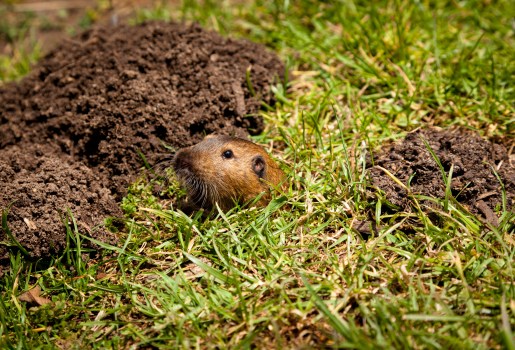
A gopher next to mounds of dirt peaking out of a hole. (Getty Images)
DEAR JOAN: What critter is making small holes in my garden?
No damage or chewing on plants is obvious, but I want to avoid any untoward effects. There are no mounds like what a gopher makes.
— Weldon Wong, Atherton
DEAR WELDON: Your question is a reminder that now is a good time to inspect lawns and planting areas, checking for damage, areas that need a little tender loving care and drainage from all the rain.
The holes you found could be caused by a number of creatures, but the good news is they probably won’t create any significant damage.
Because there are no mounds and the garden doesn’t appear ravaged, we can eliminate raccoons, opossums and skunks, and cross gophers and moles off your list. Although not every hole these animals dig has a mound, you would find mounds scattered somewhere throughout your garden. The holes also are too small for gophers, moles and ground squirrels.
If the holes are golf ball sized and near the base of trees or edges of lawns, you might have voles and would then also likely see trails in the grass.
The holes instead might be caused by animals burying food or digging up something they have stored. In that case, you’re looking at tree squirrels or larger birds, such as crows, mockingbirds and scrub jays. Keep an eye out for empty nut shells scattered near the holes.
Or — for holes 2 to 4 inches in diameter — rats could be to blame. We don’t often think about rats digging underground burrows, but some do.
Adding to the confusion, bees and earthworms also do some excavating. Solitary bees dig holes in bare soil to lay eggs and store food. Bees are good for the environment, and they pollinate our plants, so it’s always a good idea to leave some patches of bare earth for them to do their work.
Earthworms are more discreet with their holes, but if you find small piles of what looks like mud, you’re seeing evidence of the worms at work. Those piles are worm castings – worm poop – and a gift to us, since the castings are an excellent fertilizer.
The best way to know for certain is to keep watch and try to find the creature at work.
DEAR JOAN: Where are our wild birds? Last winter, November through January, I used up two to three 25-pound bags of seed plus peanuts. This winter less than a bag has been used up.
I’ve seen some doves, a couple of towhees and a titmouse, but no chickadees, no juncos, and even the crows seem to be diminished.
— Sandra DiGiulio, Mountain View
DEAR SANDRA: Although we worry about our feathered friends, there is nothing nefarious that I’m aware of that would account for a large-scale absence of birds. It’s more likely that the birds that visited your yard last winter were unable to find enough food in the wild to satisfy them.
With all the rain, food supplies are likely more ample this winter, and despite our generosity and delicious supply of food, there’s nothing like Mother Nature’s home cooking. I’m sure they’ll be back to sample your offerings eventually.
Animal Life runs on Mondays. Reach Joan Morris at [email protected].
